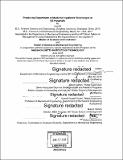| dc.contributor.advisor | Jacob Cohen and Kamal Youcef-Toumi. | en_US |
| dc.contributor.author | Qi, Ling, S.M. Massachusetts Institute of Technology | en_US |
| dc.contributor.other | Leaders for Global Operations Program. | en_US |
| dc.coverage.spatial | n-us--- | en_US |
| dc.date.accessioned | 2018-09-17T15:51:43Z | |
| dc.date.available | 2018-09-17T15:51:43Z | |
| dc.date.copyright | 2018 | en_US |
| dc.date.issued | 2018 | en_US |
| dc.identifier.uri | http://hdl.handle.net/1721.1/117962 | |
| dc.description | Thesis: M.B.A., Massachusetts Institute of Technology, Sloan School of Management, in conjunction with the Leaders for Global Operations Program at MIT, 2018. | en_US |
| dc.description | Thesis: S.M., Massachusetts Institute of Technology, Department of Mechanical Engineering, in conjunction with the Leaders for Global Operations Program at MIT, 2018. | en_US |
| dc.description | Cataloged from PDF version of thesis. | en_US |
| dc.description | Includes bibliographical references (page 67). | en_US |
| dc.description.abstract | In the last few years, US hospitals have faced severe challenges with bed capacity management that leads to capacity congestion. Delivering patients to the right bed at the right time is very important to patient care quality. However, the current process employs a self-reporting system to receive bed availability from each unit. This method does not provide consistent estimates nor does it provide a standardized, proactive bed capacity management perspective. In addition, the Department of Medicine (DOM) has a very complex patient population, both clinically and non-clinically. Various team structure and uneven distributed bed resources introduce additional challenge on patient discharges. The project aims to develop a predictive analytics tool that consistently and reliably identifies potential patient discharges in the next 24 hours. The prediction tool allows hospitals to incorporate a more proactive bed capacity management process. Every day, a ranked list with each patient's likelihood to be discharged will be the output. This list guides a more focused conversation within the care team to make patient discharge decisions. In addition, the prediction tool provides a comprehensive summary of barriers to discharge. In this work, we extended the model developed by Zanger [9] for predicting surgical patients' discharges to medicine inpatients' discharge prediction. By partitioning the training and validation set by the date on 12/31/2017, the current performance for the full model on January 2018 medicine inpatients has a prediction power of - 0.74 (Area Under Curve of a Receiver Operating Characteristic curve - AUC ROC there onwards). We further evaluated the model performance for specific patient populations. With patients' Length-Of-Stay (LOS) up to 3 days, the model's performance in terms of AUC ROC can reach ~ 0.8; 0.78 for model with patients' LOS up to 5 days, 0.77 for model with patients' LOS up to 7 days, and 0.72 for model with patients' performance up to 12 days. In addition, the model can capture 57.8% discharges in the next 48 hours, and 33.1% discharges in the next 24 hours. | en_US |
| dc.description.statementofresponsibility | by Ling Qi. | en_US |
| dc.format.extent | 67 pages | en_US |
| dc.language.iso | eng | en_US |
| dc.publisher | Massachusetts Institute of Technology | en_US |
| dc.rights | MIT theses are protected by copyright. They may be viewed, downloaded, or printed from this source but further reproduction or distribution in any format is prohibited without written permission. | en_US |
| dc.rights.uri | http://dspace.mit.edu/handle/1721.1/7582 | en_US |
| dc.subject | Sloan School of Management. | en_US |
| dc.subject | Mechanical Engineering. | en_US |
| dc.subject | Leaders for Global Operations Program. | en_US |
| dc.title | Predicting department of medicine inpatients' discharges at US hospitals | en_US |
| dc.type | Thesis | en_US |
| dc.description.degree | M.B.A. | en_US |
| dc.description.degree | S.M. | en_US |
| dc.contributor.department | Leaders for Global Operations Program at MIT | en_US |
| dc.contributor.department | Massachusetts Institute of Technology. Department of Mechanical Engineering | |
| dc.contributor.department | Sloan School of Management | |
| dc.identifier.oclc | 1051237607 | en_US |
